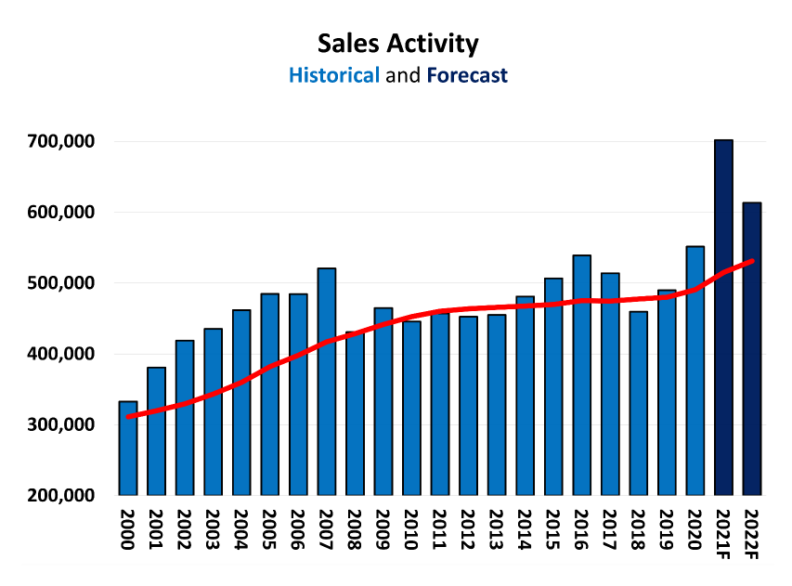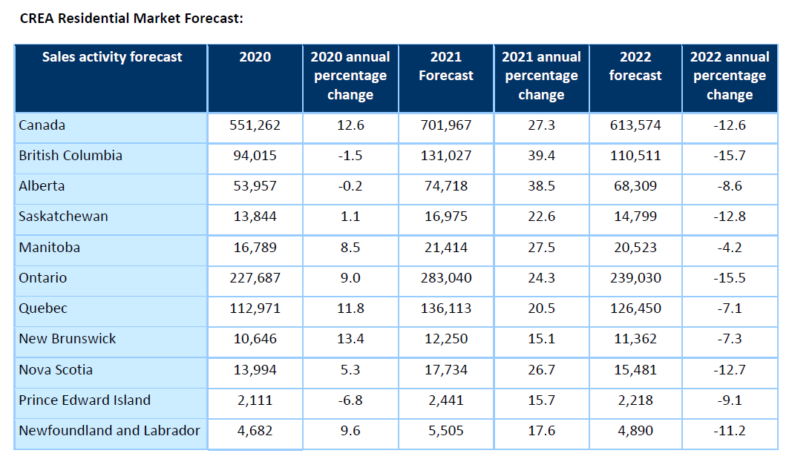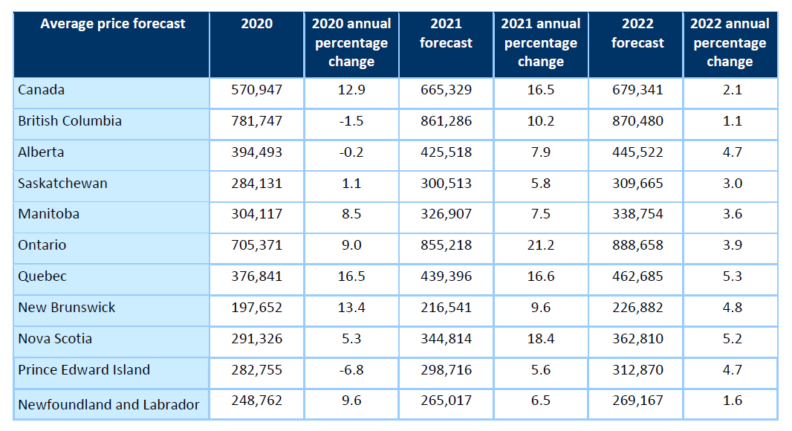Market forecast to begin easing from current record levels over the second half of 2021 and into 2022
Ottawa, ON March 15, 2021 – The Canadian Real Estate Association (CREA) has updated its forecast for home sales activity via the Multiple Listing Service® (MLS®) Systems of Canadian real estate boards and associations.
Current trends and the outlook for housing market fundamentals suggest activity will remain strong through 2021, resulting in a record number of sales. That said, activity is forecast to begin returning to more typical levels over time. 2022 is expected to see fewer MLS® transactions compared to 2021, while remaining above all other years on record.
Over the past several years, record levels of international immigration (not including 2020), low interest rates, and an increasingly middle-aged Millennial cohort have all fueled strong household formation and housing demand in Canada. Recall that prior to COVID-19, the number of available listings nationally was already at a 14-year low and the national number of months of inventory on the eve of the lockdowns had fallen to below four months (seller’s market territory). COVID-19 has only served to supercharge trends that were already present.
The pandemic has changed the relationship that many people have with housing. For many, home has been everything over the last year. It has resulted in an increased desire for a place of one’s own, for more spacious properties and bigger yards. At the same time, the calculus around home’s proximity to work, typically one of the biggest factors in choosing where to live, has changed considerably this year, and probably to some extent forever. As a result, strong first-time home buying activity is teaming up with a surge in existing owners choosing to pull up stakes and move in recent months.
Add in record-low mortgage carrying costs and you have a recipe for record, or at least historically strong, levels of MLS® activity in all parts of the country. The flip side of that coin are people for whom the pandemic has been a reason not to engage in the housing market over the last year, particularly on the supply side. Inventories are down across Canada, more so than ever before, while at the same time demand is setting almost unbelievable monthly records. This dynamic is playing out on the price side in the form of rising prices everywhere. This in turn, may be pulling even more demand forward from the future as buyers feel increased urgency to lock in current prices at record low mortgage rates.
Economic activity has been stronger than expected over the winter months. While mortgage interest rates declined throughout 2020 and are still near all-time lows, inflationary fears have surfaced to start 2021. That said, at this point the Bank of Canada is signaling that it wishes to keep interest rates low over the remainder of 2021 and through 2022. Additionally, mass vaccination of the population is not far off, which will trigger a reopening of the hard-to-distance sectors of the economy that have struggled most with the virus, and a re-acceleration on the immigration front as well.
Some 701,000 properties are forecast to trade hands via Canadian MLS® systems in 2021. The strength of demand is geographically broad-based and CREA anticipates double-digit sales growth in every province. While CREA’s previous forecast was also for a record number of sales in 2021, activity has been much stronger than expected and this represents a large upward revision resulting from the incredible growth in sales over that last number of months. For reference, the new all-time monthly record set in February 2021 was over 783,000 sales on a seasonally adjusted annual basis.
The national average home price is forecast to rise by 16.5% on an annual basis to just over $665,000 in 2021. This reflects the current unprecedented imbalance of supply and demand, currently at less than 2 months of inventory nationally to begin 2021. Conditions are now favouring sellers to some extent in virtually all local markets. The vast majority of Ontario markets are now into weeks of inventory. As with the annual sales figures, CREA believes this average price forecast to be well on the conservative side, in relation to current monthly data.
On a monthly and quarterly basis, sales are forecast to begin trending down towards more typical levels through the latter half of 2021 and into 2022. Limited supply and higher prices are expected to tap the brakes on activity in 2022 compared to 2021, although increased churn in resale markets resulting from the COVID-related shake-up to so many people’s lives will likely continue to boost activity above what was normal before COVID-19. Indeed, it is possible that many of the moves associated with changes related to increased remote work won’t play out until a little further down the road when we have more certainty about what the future will look like post-COVID.
National home sales are forecast to fall by 12.6% to around 614,000 units in 2022. This easing trend is expected to play out across Canada as higher prices and a lack of available supply impacts all areas of the country, as previously pent-up demand in exhausted, and as the urgency to purchase a home base to ride out the pandemic fades along with the virus itself.
The national average price is forecast to edge up by just 2.1% $679,000 in 2022 as the current demand-supply imbalance unwinds.



- 30 -
About the Canadian Real Estate Association
The Canadian Real Estate Association (CREA) is one of Canada’s largest single-industry associations. CREA works on behalf of more than 135,000 REALTORS® who contribute to the economic and social well-being of communities across Canada. Together they advocate for property owners, buyers and sellers.
For more information, please contact:
Pierre Leduc, Media Relations
The Canadian Real Estate Association
Tel: 613-237-7111 or 613-884-1460
E-mail: pleduc@crea.ca